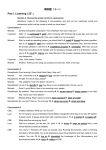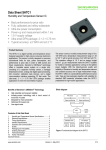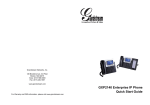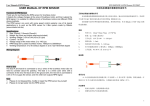Download English Proficiency Test for IT Professionals, Level One
Transcript
模拟题(六) Part I. Listening Comprehension Section A: Short Conversations Directions: In this section you will hear 10 short conversations. At the end of each conversation, you will be given 20 seconds to read the 4 statements marked A, B, C and D, and decide which one is correct based on what is stated or implied in the conversation. You will hear each conversation ONLY ONCE. Click the corresponding radio button signifying the correct answer. 1. A. The woman is trying to get help from her colleague. B. The woman is trying to get technical support on site. C. The woman is trying to ask the tech support about the user manual. D. The woman is trying to help the man solve his problem. 2. A. The man is asking the woman to make a cake. B. The man is helping the woman with her task. C. The man is asking the woman about her responsibility. D. The man is assigning work to the woman. 3. A. The man is likely to be the boss of the woman. B. The man is likely to be the technical support engineer. C. The man is likely to be a customer. D. The man is likely to be the colleague of the woman. 4. A. The man is interested in having a network function of the software. B. The software will not work with the Internet. C. The woman is probably the client of the man. D. The man wants some new functions for the software. 5. A. The man is worrying about if they can finish the work on time. B. There are still many parts of the software unfinished. C. The man is confident that they will meet the deadline. D. They have finished the whole project. 6. 1 A. The man knows he doesn’t have time next Saturday. B. The man is considering whether to see the general manager or not. C. The man doesn’t know if he is available next Saturday. D. The man seems to be the secretary of the woman. 7. A. The man is a subordinate of the woman. B. The woman is not sure about how much work they have finished. C. The woman knows about the progress. D. The woman is a client of the man. 8. A. Mr. Lee is not available at the moment but will soon be able to talk to the caller. B. Mr. Lee is going to have a meeting in the next few hours and can’t answer the phone. C. Mr. Lee can answer the phone right away. D. Mr. Lee will not answer the phone because he doesn’t want to. 9. A. The man is satisfied with the memory that the woman bought. B. The woman agrees with the man. C. The woman apologizes for buying the wrong brand. D. The man thinks stability is very important. 10. A. The clients are satisfied with the designed product. B. The clients don’t want the software to have any new function. C. The woman is not happy with the clients’ new demand. D. They have spent 2 years developing for this client. Section B: Fill in the Blanks Directions: In this section you will hear one passage. The passage will be read TWICE. You must listen carefully in order to fill in the 10 gaps with the missing information. Now listen to the passage please. An _____ is a document describing the __________ of a computer system from the user’s point of view. Software (同上) Specifications provide us with a good basis upon which we can both _______ a great plan and _____ deficiencies in our past 2 efforts. The IEEE 830 Standard defines the ________ of a good SRS: First, establish the basis for agreement between the ______ and the suppliers on what the software product is supposed to do. Second, reduce the development ______.Third, provide a basis for estimating costs and________. Fourth, provide a baseline for validation and verification. Fifth, facilitate ______. Sixth, serve as a basis for enhancement. In fact, without a good SRS, a software project will definitely _______. PartII. Oral Expression Section A: Business Communication Directions: In this section you need to express yourself in a given scenario. After you have read the instruction, you may make preparations for your talk first. Then you can press the Record button and start your talk. When you have finished, press the Stop button. You can listen to your talk by pressing the Play button. If you are satisfied with the current version, press Submit; if not, you can record again. You can only record TWICE for each scenario. You have 10 minutes for this section. Please pay attention to the time limit, and submit in time. Scenario: Suppose you are a newcomer to General Computers as a software engineer. This is the first time for you to meet with your colleagues. Please make a complete self introduction which will include all the following information: your name, hometown, your higher education background, your hobbies, and why do you love to work for General Computers. Section B: Technical Communication Directions: In this section you need to express yourself on one of two given topics. After you have read the two topics, you have to choose one as the topic for your talk. After you have made preparations for your talk, you can press the Record button and start your talk. When you have finished, press the Stop button. You can listen to your talk by pressing the Play button. If you are satisfied with the current version, press Submit; if not, you can record again. You can only record TWICE for each scenario. You have 10 minutes for this section. Please pay attention to the time limit, and submit in time. 3 Optional Scenario 1: Please introduce your technical background; be sure to include courses in computer sciences, technological skills or programming languages you have taken and mention what kind of part-time jobs you have done or what internship (实习) experience you have. Optional Scenario 2: Please share with us your most exciting development experience and why you like this project. Part III. Vocabulary & Structure (20 points, 20 minutes) Directions: There are 20 incomplete sentences in this part. Beneath each sentence you will find four words or phrases marked A, B, C and D. Choose the one answer that best completes the sentence. Then, on Answer Sheet I, find the number of the question and fill in the space that corresponds to the letter of the answer you have chosen. You have 20 minutes for this part. 1. Many large ________ run special courses for their employees. A. organizations B. C. families D. 2. nations unions He ________ a master’s degree in computer science by taking classes at night. 3. A. informed B. dropped C. required D. acquired Through exceptional technologies and pricing advantages, they were able to gain the ________ edge. 4. A. political B. competitive C. compatible D. marginal I had asked everyone to ________ the application form in advance of the meeting. 5. A. admit B. submit C. recover D. discover Michael asked his client to _______the deadline for delivery as they have a tight budget. A. advance B. 4 meet C. postpone 6. D. miss The expert committee will study the ________ of setting up a national IPv6 network. 7. A. feasibility B. functionality C. credibility D. disability The Microsoft TechNet provides the ________ to discuss a number of issues that were not covered in the MSDN community. 8. A. valley B. discussion C. forum D. frame Online gaming allows players from around the world to ________ each other. 9. A. change B. charge C. challenge D. indulge Your information is stored in log files for analysis, research, auditing, and other purposes, until the information is ________ to the backup database. A. stuck B. transferred C. translated D. stimulated 10. If you’re interested in a subject, use the Internet to ________ deeper. A. delve B. deploy C. delete D. debug 11. Hundreds of ideas ________________ during two years of brainstorming before a final design was eventually reached. A. had tried and discarded B. are tried and discarded C. being tried and discarded D. had been tried and discarded 12. You are __________ your own schedule page and can customize that page to inform colleagues of your work plan. A. take charge of B. under charge of C. in charge of D. in charge for 13. A wide range of options allows customers to plan a coherent combination of configuration _________ their interests in computer applications. A. in line for B. in line with C. accord to D. to betray 14. Computer users expect green monitor screens which can ________ radiation to be produced soon. A. decrease down B. rise up C. fill in D. filter out 5 15. When calculating budgets, remember to ________________ the tangible costs like gas, oil, tolls, extra meals, and hotel rooms you will have to pay for. A. bring into consideration B. take into consideration C. think up D. think for 16. This Online Contact Manager enables you to ________________ your contacts and classify them according to different categories. A. keep ahead of B. keep out C. keep track of D. keep off 17. 1% rule is an emerging ____________ that suggests that if you get a group of 100 people online then one will create content, 10 will “interact” with it and the other 89 will just view it. A. rule of game B. rule of interest C. rule of phenomenon D. rule of thumb 18. Google _______ providing the best searching engine to the world. A. is bent to B. is dedicated to C. gives up to D. denies to 19. Computers continue to ____________, software still contains bugs, people sometimes make mistakes. A. get repaired B. get updated C. break into D. break down 20. In the third chapter the items _______________ and all things needed for the tests are mentioned. A. will test B. is tested C. have tested D. to be tested Part III. Reading Comprehension (20 points, 40 minutes) There are three passages in this part. Answer all the questions about information in these passages on the basis of what is stated or implied in each passage. You have 40 minutes for this part. Section A: Normal Reading Directions: In this section you will read two passages at normal speed. Each one is followed by 5 questions about it. You will choose the best answer, A, B, C, or D, to each question. Then, on Answer Sheet I, find the number of the question and fill in the space that corresponds to the letter of the answer you have chosen. 6 Read the following passage: Passage 1 Today’s top-of-the-line computers have dual-core processors: two computing units that can handle separate tasks at the same time. And by next year, major chip makers Intel and AMD will have rolled out quad-core systems. Although multiple processors are theoretically faster than a single core, writing software that takes advantage of many processors--a task called parallel programming--is extremely difficult. Recent research from MIT, however, could make parallel programming easier, ultimately helping to keep personal-computing performance on track. The researchers are proposing a new computing framework that combines specialized software instructions and modifications to multi-core hardware that could allow programmers to write software without having to deal with some tedious parallel-programming details. Historically, writing software for multi-core systems has been the job of experts in the supercomputing world. But with the coming age of personal supercomputers, average programmers also need to be able to write software with multiple cores in mind. “That’s a scary thing,” says Krste, professor of electrical engineering and computer science at MIT, “because most have never done that, and it’s quite difficult to do.” Krste and his colleagues are tackling one of the main challenges that programmers face when they try to write software that will run efficiently on multi-core systems: coordinating multiple tasks that run on separate cores in a way that doesn’t cause the system to crash. When an application such as Microsoft Outlook or a video player is parallelized, certain tasks are divvied up among the processors. But often, these separate tasks need to dip into a shared memory cache to access data. When one transaction is accessing memory and another transaction needs to access the same part of the memory, and proper safeguards aren’t put in place, a system can crash. This can be compared to a couple with a shared checking account with limited funds writing checks simultaneously and inadvertently overdrawing from the account. Standard parallel programming requires a programmer to anticipate these simultaneous activities and make sure that once a certain activity begins to access memory, it “locks” out other activities so they wait until the transaction is completed. When implemented correctly, the locks speed up parallel systems, but putting them into practice is complicated, says Jim Larus, research area manager at Microsoft. For instance, he explains, two different applications could acquire locks at the same time, 7 which forces them to wait for each other. Without some third party coming in to break up the “deadlock,” Larus says, the applications would stay frozen. 21. What can be known about computers with multi-core processors? A. They are faster than a single-core computer in theory. B. Many people have already used personal computers with such processors. C. Computers with quad-core systems have been put on shelves. D. Most programmers are able to develop software that runs on multi-core processors. 22. Which of the following about parallel programming is NOT TRUE? A. It’s not so difficult as it was before. B. MIT researchers contribute a lot to making parallel programming easier. C. It’s very hard to assign tasks well to multi-core processors. D. Parallel programming has prevailed in personal computing. 23. According to the passage, which of the following is TRUE? A. Only experts in the supercomputing world can write software for multi-core processors. B. The computing framework that facilitates programmers with parallel programming has already been established. C. Several programs cannot access the same data in the memory simultaneously. D. Personal computers never crash whatever has happened to them. 24. What does the author imply by “standard parallel programming requires a programmer to anticipate these simultaneous activities and make sure that once a certain activity begins to access memory, it ‘locks” out other activities so they wait until the transaction is completed”? A. Parallel programming only deals with simultaneous activities. B. One program doesn’t need to wait until another program finishes accessing the data. C. Any program can automatically prevent others from accessing the memory when it does so. D. It is the programmer’s responsibility to make sure programs access the memory in order. 25. What does this passage mainly discuss? A. MIT researchers create a parallel programming framework. 8 B. Difficult parallel programming is the problem that hinders the multi-core systems. C. How the programs can access the memory safely. D. What programmers should do to allocate programs to multiple-core systems. Passage 2 “You never get a second chance to make a first impression.” It’s quoted in articles on topics from interviewing for jobs to designing websites. But it concisely conveys a basic truth of human nature: we draw conclusions about new experiences, new people, and new things very quickly. Installing Vista on two computers might seem a bit excessive, but the Windows operating system is made for two different kinds of processors: 32-bit and 64-bit. By working with bigger chunks of data, the newer 64-bit processors can better handle intensive tasks such as video editing and playing advanced games. But most desktop and laptop computers in use—and plenty of those on store shelves—have older 32-bit processors, so Microsoft built two versions of Vista. Vista looks tidy. The old squared-off windows now have rounded corners. The rectangular “start” button in the lower-left corner of the screen has been supplanted by a pretty circle with the Windows logo. A transparent rectangle, called the Sidebar, runs down the right side of the screen. The Sidebar holds “gadgets,” mini-applications that provide quick access to frequently needed information and tools. Vista comes with 11 such gadgets, 3 of which load the first time you start up: an analog-style clock, a slideshow viewer, and a newsreader with a collection of headlines from MSNBC.com and Microsoft. Of all the Sidebar applications, the Feed Headlines gadget—which can be customized with your favorite—stands out. As with Apple’s Spotlight, search boxes appear at the top of every window, making it easy to hunt down the file you’re seeking. And searching with Instant Search is both faster and more effective than searching in Windows XP. Instantly after copying files from personal PC to the test laptop, you can try to type “DNA sequencing” into the search box. Despite the fact that none of the files had been indexed, Vista found every relevant file within two minutes—even those that used some variation of the word “sequencing.” This is an enormous improvement over most users’ consistently frustrating experiences with Windows XP’s search function, which frequently did not find the file they wanted and, for any comparable search, took much longer. And if 9 you’d like to improve search results even more, Vista allows you to add “tags” —short text descriptors like those used on websites such as del.icio.us and Flickr—to any file. 26. Which of the following about Windows Vista does the passage NOT mention? A. It has two versions. B. It has a 16-bit version of Vista. C. The interface of Vista looks better than Windows XP. D. Vista provides a news headline gadget. 27. Which of the following is NOT TRUE about the difference between 32-bit and 64-bit processors? A. 64-bit processors can handle complicated tasks better. B. 64-bit processors are much slower than 32-bit processors. C. 64-bit processors can deal with more bulks of data with great speed. D. Computers with 64-bit processors don’t take more space than those with 32-bit processors. 28. What can NOT be inferred from “the Sidebar holds ‘gadgets’, mini-applications that provide quick access to frequently needed information and tools”? A. Gadget is a type of applications. B. Users can quickly start up frequently used applications from Sidebar. C. The place where those gadgets are placed is called Sidebar. D. The start up of all applications is completed through gadgets. 29. According to the passage, which of the following about Vista and Windows XP is TRUE? A. Searching files is much faster in Windows XP than in Vista. B. The searching function in Windows XP doesn’t work at all. C. Improvements have been made in Vista. D. In Windows XP, you can find anything but the file you want. 30. What can you infer from the passage? A. The rectangular “start” button is located in the lower-left corner of the screen, while the transparent rectangle “Sidebar” is located in the lower-right side of the screen. B. Slideshow viewer is one of the 4 gadgets that load the first time users start up. C. Users of Windows XP will turn to Vista in the future. 10 D. Vista performs better than Windows XP in a number of ways. Passage Three A database is similar to a data file in that it is a storage place for data. Like a data file, a database does not present information directly to a user; the user runs an application that accesses data from the database and presents it to the user in an understandable format. Database systems are more powerful than data files in that data is more highly organized. In a well-designed database, there are no duplicate pieces of data that the user or application must update at the same time. Related pieces of data are grouped together in a single structure or record, and relationships can be defined between these structures and records. When working with data files, an application must be coded to work with the specific structure of each data file. In contrast, a database contains a catalog that applications use to determine how data is organized. Generic database applications can use the catalog to present users with data from different databases dynamically, without being tied to a specific data format. A database typically has two main parts: first, the files holding the physical database and second, the database management system (DBMS) software that applications use to access data. The DBMS is responsible for enforcing the database structure, including: Maintaining relationships between data in the database. Ensuring that data is stored correctly and that the rules defining data relationships are not violated. Recovering all data to a point of known consistency in case of system failures. Structured Query Language To work with data in a database, you have to use a set of commands and statements (language) defined by the DBMS software. Several different languages can be used with relational databases; the most common is SQL. The American National Standards Institute (ANSI) and the International Standards Organization (ISO) define software standards, including standards for the SQL language. SQL Server 2000 supports the Entry Level of SQL-92, the SQL standard published by ANSI and ISO in 1992. The dialect of SQL supported by Microsoft SQL Server is called Transact-SQL (T-SQL). T-SQL is the primary language used by Microsoft SQL Server applications. 31. About the database, which of the following description is true? A. A database presents information directly to a user. B. A database contains a catalog that applications use to determine how data is organized. 11 C. A database is a data file. D. A database typically has three main parts. 32. The word “duplicate” in Line 6 is close to A. smart. B. same. C. different. D. simple. 33. Which of the following statements about DBMS is WRONG? A. It may help maintain relationships between data in a database. B. It may recover all data to a point of known consistency in case of system failures. C. It does not help strengthening the database structure. D. It helps to ensure that the data is stored correctly. 34. All the following languages can be used with relational databases, except A. T-SQL. B. SQL. C. SQL-92. D. BASIC. 35. Which of the following can be inferred from the article? A. Database systems are no more powerful than data files. B. You cannot use natural languages to work with a database. C. A database typically has two main parts. D. SQL is developed by Microsoft. Part V. Composition (20 points, 30 minutes) Directions: In this part, you are given 30 minutes to write an e-mail according to a given scenario. This assignment consists of several mini-tasks for business and technical communication. You should include all given information, but not be confined to its content or order. Write about 300 words on Answer Sheet II. Do not sign your own name at the end of this composition. 你是 General Talent 公司的软件工程师 Jacky Zhang ([email protected]),你负责 GTT 企业 信息管理系统(GTT Corporate Information Management System)的研发工作。该系统是为 EST 公司定制开发的。现在正在编码阶段,你需要给 EST Soft 公司的 Alan Johnson ([email protected]) 先生写信说明下面情况: 1. 有关正在设计的薪酬计算模块,经进一步与对方人员沟通,其需求与第一次确定 的有所不同,经再次商定得到的软件需求规格说明书第二版在附件中,请对方签 字确认。并希望今后不会再有改动。 2. 向对方通报目前进度:已经完成三个独立模块的设计工作,它们分别是用户注册 模块、后台管理模块和库存管理(Stock Management)模块。 12 3. 对方曾经提出过信息通知系统希望使用第三方插件 ABC Messenger。根据经验, 这有可能会产生与目前系统的兼容性问题,请对方再次考虑是否坚持使用第三方 控件。 4. 为提高沟通效率,希望对方能够派两名代表参加面对面的开发讨论会。此次会议 的时间和地点:10 月 10 日上午 9 点,清华大学学研大厦多功能厅(Multi-purpose Hall,R&D Plaza,Tsinghua University) ,我方有关研发人员届时将全部到场,希 望与对方沟通愉快顺利。 13 参考答案 Part I. Listening Comprehension BDCBC CCADC Section B: Fill in the Blanks 1. SRS 2. requirements 3. define 4. identify 5. benefits 6. customers 7. effort 8. schedules 9. transfer. 10. go wrong 14

















